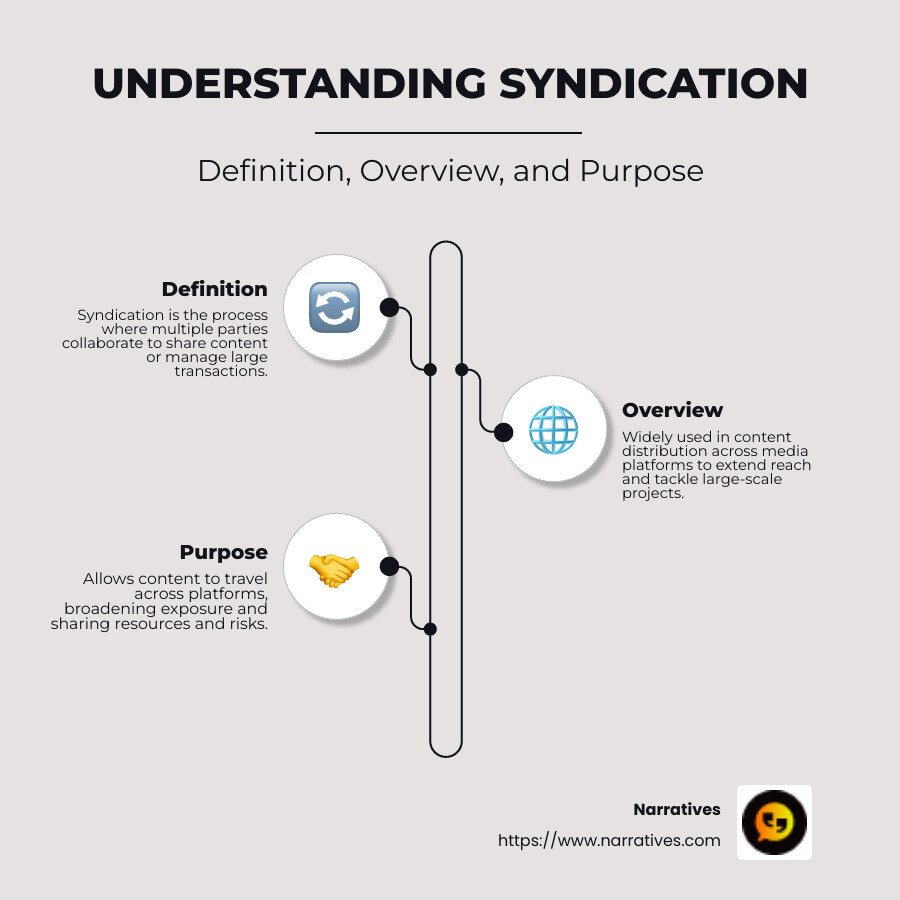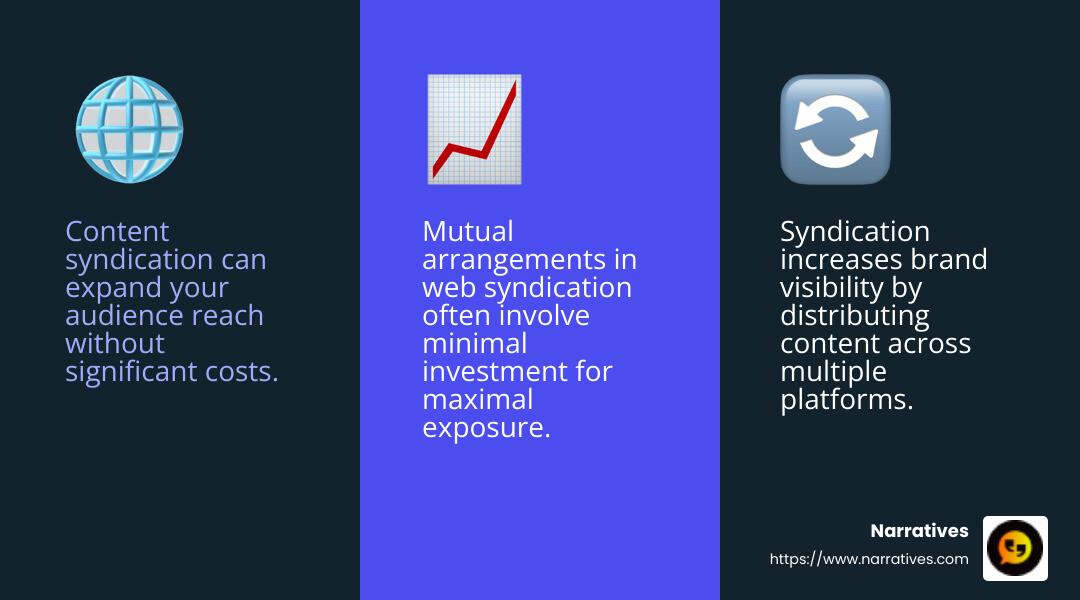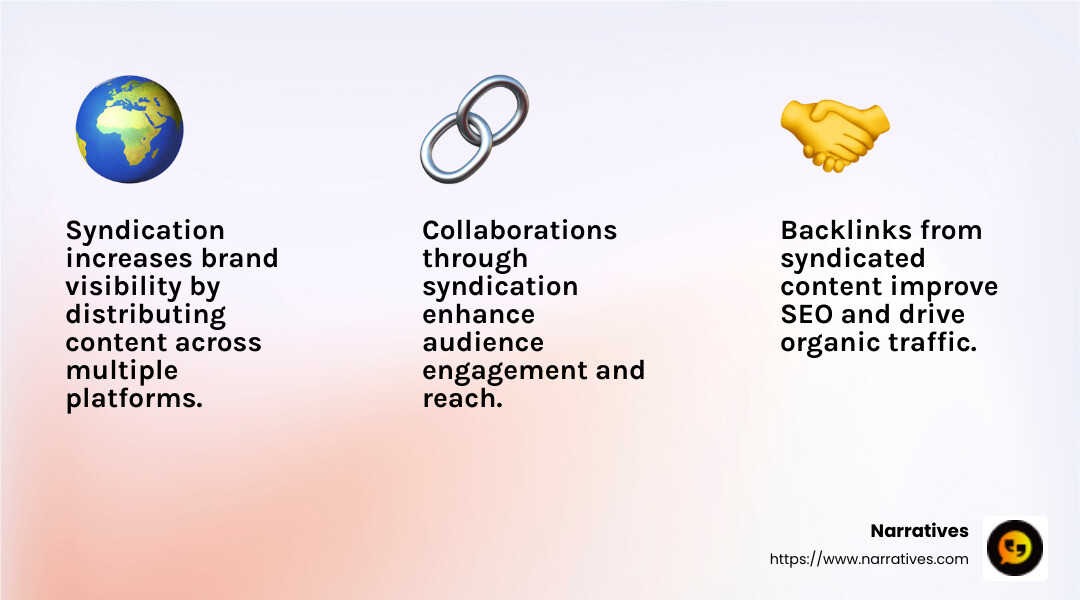Understanding Syndication: A Complete Guide

Syndication meaning can be defined as the process where multiple parties work together to share content or manage a large transaction that is difficult to handle alone.
In today's digital landscape, syndication is becoming an essential strategy, especially for organizations focused on storytelling and social impact. Whether you're a non-profit leader or a marketing professional, understanding syndication can amplify your mission effectively.
Why Syndication Matters
- Definition: Syndication involves collaboration, where parties share content or business efforts to achieve a common goal.
- Overview: It's widely used in content distribution across media platforms, letting organizations extend their reach effortlessly. Syndicates can also form in business settings, allowing firms to tackle large-scale projects.
- Purpose: For media, syndication allows content to travel across platforms, widening audience exposure. In business, it helps companies share resources and risks.
Syndication acts as a bridge, allowing different entities—media outlets, businesses, or non-profits—to collaborate efficiently.

Simple syndication meaning word guide:
What is Syndication?
Syndication meaning can be defined as a collaborative process where content or resources are shared across multiple platforms or parties. This approach is particularly useful for extending the reach of content, whether it's articles, videos, or other media types.
Content Distribution
At its core, syndication is all about content distribution. This involves sending content from one source to multiple outlets, allowing it to reach a broader audience. For example, a blog post originally published on a smaller website might be syndicated to larger platforms, increasing its visibility and impact.
- Key Benefit: The original content creator gains more exposure and traffic, while the syndicating platform enriches its offerings with fresh, diverse content.
Media Sharing
Media sharing through syndication is a powerful tool for both content creators and distributors. It allows creators to showcase their work on multiple platforms without having to create new content for each one. For instance, a podcast episode might be shared across various streaming services, reaching listeners who prefer different platforms.
- Example: Think of a TV show that originally airs on one network but is later syndicated to other networks. This not only increases viewership but also maximizes the content's value.
The Role of Syndication in Digital Media
Syndication has evolved beyond traditional media. It's now a vital strategy for online platforms looking to boost their content variety and appeal to diverse audiences. Websites often use syndication to include "related posts" or "similar articles" sections, enhancing user engagement and keeping visitors on their site longer.
- Fast Fact: Syndication is not just a modern invention. It's the digital version of content sharing that has existed since the early days of print, radio, and television.
Syndication provides a win-win scenario, offering content creators a path to greater exposure while enabling platforms to deliver more comprehensive and engaging content to their audiences.
Types of Syndication
Syndication comes in several forms, each serving different purposes but all aimed at expanding reach and sharing resources. Let's explore the three main types: content syndication, media syndication, and financial syndication.
Content Syndication
Content syndication involves sharing written or visual content across multiple platforms. This is a common practice for bloggers, news outlets, and websites looking to amplify their reach.
How It Works: A piece of content, like a blog post, is published on a primary site and then distributed to other sites. These partner sites republish the content, often linking back to the original source.
Benefits: The original creator gains more visibility and potentially more traffic, while the syndicating sites get fresh content to engage their audience.
Real-World Example: A blog post from a small niche site might appear on a larger platform, such as a well-known news website, reaching a broader audience.
Media Syndication
Media syndication is similar to content syndication but focuses on multimedia content like TV shows, podcasts, and videos. This type of syndication is prevalent in the entertainment industry.
How It Works: A TV show or podcast episode airs on its original network and is later syndicated to other networks or platforms.
Benefits: This allows the content to reach viewers or listeners who prefer different channels or platforms, maximizing its audience.
Example: A popular TV show might initially air on a major network and then be syndicated to local stations or streaming services, increasing viewership.
Financial Syndication
In the financial world, financial syndication involves a group of entities, often banks or investment firms, pooling resources for a large transaction. This type of syndication is crucial for handling big projects or investments.
How It Works: Companies form a temporary alliance, called a syndicate, to manage a transaction or investment that would be too large or risky for a single entity to handle alone.
Benefits: Members share both the risks and rewards, making it easier to manage large-scale financial undertakings.
Example: Investment banks might form a syndicate to underwrite and distribute a new issue of securities, sharing the risk and profit from the underwriting spread.
Syndication—whether in content, media, or finance—offers a strategic method for expanding reach, sharing resources, and managing risks. Each type plays a vital role in its respective field, enabling more efficient and effective distribution of content, media, or financial resources.
Benefits of Syndication
Syndication offers a host of advantages, especially for those looking to expand their reach and influence. Let’s explore some of the key benefits: increased reach, brand visibility, and audience engagement.
Increased Reach
Syndication meaning revolves around the idea of spreading content far and wide. By sharing your content across multiple platforms, you can tap into new audiences that might not have finded your work otherwise. This is especially valuable for small content creators or niche websites that want to reach a broader audience without significant marketing costs.
Example: A blog post originally published on a small personal blog can be syndicated to larger sites, like a major news outlet, reaching thousands more readers.
Fact: Web syndication can significantly increase exposure with minimal investment, as it often involves free arrangements that are mutually beneficial.

Brand Visibility
Syndicating content can also boost brand visibility. When your content appears on various platforms, more people become familiar with your brand. This increased visibility helps establish your brand as a leader in your field.
Example: A company that syndicates its educational videos to popular online platforms can build its reputation as a knowledgeable authority, attracting more followers and potential customers.
How It Works: The more your content is seen, the more recognizable your brand becomes. This familiarity can lead to increased trust and loyalty from your audience.
Audience Engagement
Syndication doesn't just increase reach and visibility; it also improves audience engagement. By appearing on platforms where your audience is already active, you can interact with them more effectively.
Example: A podcast that is syndicated across multiple streaming services can engage listeners who prefer different platforms, increasing the chances of feedback, shares, and discussions.
Benefit: Engaging content on well-trafficked sites encourages interaction, like comments and shares, further spreading your message and creating a community around your content.
In summary, syndication is a powerful tool for expanding your reach, enhancing brand visibility, and boosting audience engagement. By strategically distributing your content, you can tap into new markets and build a stronger presence in your industry.
How Syndication Works
Syndication is all about making your content go further. It involves three main components: distribution channels, partnerships, and licensing agreements. Let’s break these down to understand how syndication operates.
Distribution Channels
Distribution channels are the pathways through which your content travels from you to your audience. These can include websites, social media platforms, newsletters, and even podcasts. The idea is to place your content where it can be easily accessed by as many people as possible.
Example: An article published on a personal blog can be distributed through platforms like Medium or LinkedIn, reaching a wider audience that doesn't visit the original site.
Fact: Web syndication often uses existing high-traffic platforms to maximize exposure without the need for significant investment.
Partnerships
Partnerships are crucial in syndication. They involve collaborations between content creators and distributors. These partnerships allow smaller content producers to leverage the audience of larger platforms.
Example: A niche website might partner with a major online publication to publish its articles, thus gaining access to a larger audience.
Benefit: Partnerships are mutually beneficial. The content creator gains exposure, while the distributor enriches its content offerings, attracting more users.
Licensing Agreements
Licensing agreements are the formal arrangements that define how your content can be used by others. These agreements specify the rights and limitations regarding the use of your content.
How It Works: Licensing agreements ensure that both parties understand how the content will be used, protecting the creator's rights while allowing the distributor to use the content legally.
Example: A company might license its educational videos to an online learning platform, ensuring the content is used appropriately and credited correctly.
By understanding these components—distribution channels, partnerships, and licensing agreements—content creators can effectively use syndication to expand their reach and influence without losing control over their work. This strategy allows for a broader audience, increased brand visibility, and improved audience engagement, paving the way for greater success.
Syndication in Digital Storytelling
Syndication plays a vital role in digital storytelling, especially for non-profits aiming to amplify their social impact and foster community engagement. Let's explore how syndication can be a game-changer in these areas.
Non-Profit Storytelling
For non-profits, storytelling is a powerful tool to share their mission and impact. Syndication allows these organizations to distribute their stories widely, reaching audiences they might not access otherwise.
- Example: A non-profit working on environmental conservation could syndicate its success stories and research findings to major online platforms, raising awareness and attracting support from a global audience.
This broad distribution can lead to increased donations, volunteer sign-ups, and partnerships, furthering the non-profit's goals.
Social Impact
Syndication can significantly improve a non-profit's social impact. By sharing stories across various channels, these organizations can inspire action and drive change on a larger scale.
Case Study: Narratives, a 501(c)(3) content agency, partners with non-profits to create and syndicate content that highlights community stories and challenges. This approach not only raises awareness but also encourages public support and involvement.
Benefit: By syndicating content, non-profits can engage a diverse audience, sparking conversations and movements that lead to real-world impact.
Community Engagement
Community engagement is crucial for non-profits, and syndication helps achieve this by bringing stories to the forefront of public discourse. When communities see their stories shared widely, it fosters a sense of pride and involvement.
Example: A local community initiative might syndicate its achievements to larger media outlets, showcasing the community’s efforts and encouraging others to join in or replicate their success.
Fact: Syndication increases the exposure of content, allowing non-profits to reach audiences beyond their immediate community, thus building a broader network of support.
By leveraging syndication, non-profits can effectively share their narratives, engage with a larger audience, and make a more significant impact. This strategy not only improves visibility but also strengthens community ties and drives meaningful change.
Frequently Asked Questions about Syndication
What is the difference between syndication and licensing?
Syndication and licensing are two terms often used interchangeably, but they have distinct meanings.
Syndication refers to the distribution of content from one platform to another. It allows for broader dissemination of material, helping the original content creator reach a wider audience. This can happen through partnerships, where content is shared across multiple sites, often at no cost. The primary goal is to increase exposure and drive traffic back to the content originator.
Licensing, on the other hand, involves granting permission to use content under specific terms. It often requires a legal agreement and may involve fees. Licensing is about controlling how content is used and ensuring that the creator receives compensation or recognition for their work.
In simple terms, syndication is about spreading content far and wide, while licensing is about allowing controlled use of content, often for a fee.
How does syndication benefit non-profits?
Syndication can be a powerful tool for non-profits aiming to amplify their mission and reach more supporters.
Increased Visibility: By syndicating content, non-profits can showcase their stories on larger platforms, reaching audiences they wouldn't typically access. This can lead to greater awareness of their cause.
Improved Engagement: When non-profits share their narratives widely, they can engage with diverse audiences. This can spark conversations, inspire action, and even attract new volunteers or donors.
Cost-Effective: Syndication is often a cost-effective way to spread a message, as it doesn't always require significant financial investment. This is crucial for non-profits that need to allocate funds efficiently.
Case Study: Narratives, a content agency, collaborates with non-profits to create and syndicate impactful stories. This partnership helps non-profits engage with a broader audience, driving support and fostering community involvement.
Can syndication help in building brand authority?
Absolutely! Syndication can significantly bolster a brand's authority in several ways:
Expert Positioning: By consistently sharing valuable content across reputable platforms, a brand can establish itself as a thought leader in its field. This builds trust and credibility with audiences.
SEO Benefits: Syndicated content often includes backlinks to the original site, improving search engine rankings and increasing organic traffic. This improves the brand's online presence and authority.
Audience Reach: Syndication allows brands to tap into new audiences, expanding their reach and influence. As more people engage with the content, the brand's reputation grows.
Quote:

Through strategic syndication, brands can not only increase their visibility but also solidify their position as leaders in their industry. This approach fosters trust and encourages long-term audience engagement.
Conclusion
In digital media, syndication plays a crucial role in expanding reach and amplifying stories. At Narratives, we understand the power of storytelling and how it can drive social impact for non-profits and purpose-driven organizations.
By leveraging syndication, we help these organizations share their stories far and wide, ensuring that underrepresented voices are heard. Our approach focuses on creating emotionally resonant multimedia content that not only builds trust but also inspires action.
Digital storytelling is about more than just sharing information; it's about connecting with audiences on a deeper level. Syndication allows us to distribute these stories across various platforms, increasing visibility and engagement. This strategy is not just beneficial for our partners, but it also positions us as leaders in community-driven storytelling.
Through effective syndication, we aim to lift the narratives that matter most, helping our partners achieve their mission and make a lasting impact. Whether it's through reaching new audiences or building brand authority, the potential of syndication in digital media is vast and transformative.
By embracing this method, we continue to support non-profits in their journey to create meaningful change, one story at a time.


